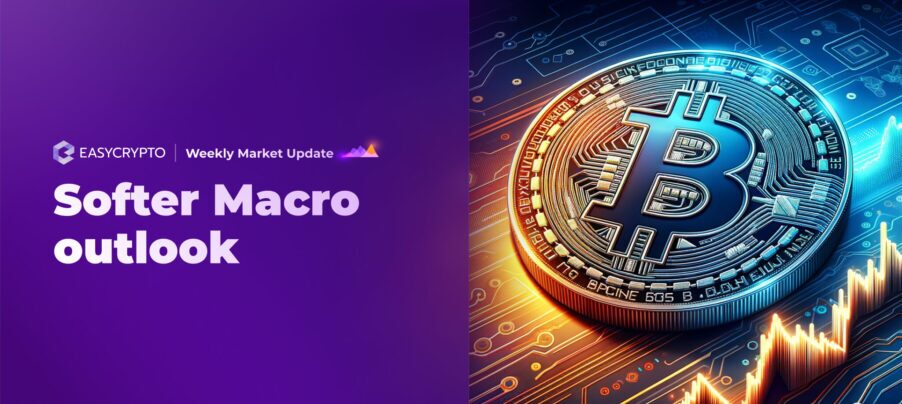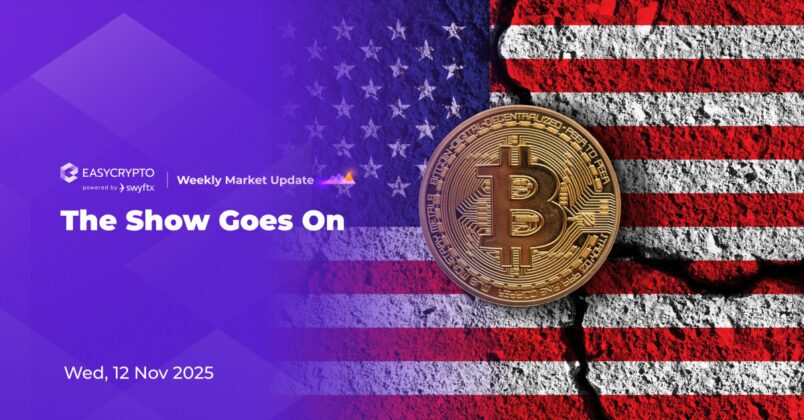Weekly Market Update: Softer Macro Outlook
In this weekly crypto market update, we take a look at the macro economic activities post Bitcoin halving. Stay tuned for more updates in the crypto space and other macro economic developments from around the world.


The weeks after halving have a history of volatility. This cycle appears to be no exception. The reasons though could be quite different. It’s all about the macro. All risk assets appear to be out of favour this week.
In crypto news, Bitcoin network difficulty and fees are up sharply due to the halving and the launch of Runes on the BTC network.
There has been a lot of ETF news too; we have now posted our 3rd week of outflows, again GBTC is the main culprit. Hong Kong’s ETFs went live… and kind of fizzled with only $11m in volume, which is kind of ominous for the Australian ETF launch imho.
Regulators had a big week. Even the Russians got in on the act. The US DoJ is apparently treating non-custodial wallets as money transmitters. And the SEC went after DoKwon and Terraform Labs. Consensys went on the front foot about Ethereum with the SEC. Boy Binance had a week! CZ got 4 months jail time, and Canadian and Philippine regulators came after them.
In better news Stripe is back in the crypto game, and the NYSE is looking at blockchain technology so it can trade 24×7.
In macro news, it is PMI week with many countries putting out their data. It was a bit of a mixed bag with the US showing a surprising decline. The persistently high US inflation is causing market angst, and the chances of a June rate cut are near zero. The FOMC speaks this week… so hold your beer. The US dollar strength is also causing havoc in many economies, including in NZ.
Europe is looking better; inflation is steady and there was some GDP growth. German and UK CPI continues to fall, but the UK has the most work to do.
Asia data was dominated by Japan. The BoJ held rates steady which caused the JPY to be at its lowest level in nearly 40 years. The BoJ looks like it intervened in the currency markets. China’s PMI numbers were back in growth territory, but paled compared to India’s.
Locally, Australia’s economy lost some shine, with PMI contracting down and CPI above forecast.
If Australia lost its shine, New Zealand is somewhere between ankle and knee deep in the ..mud. Business and Consumer confidence are both down, the cost of living is running hot, company liquidations are up and unemployment is beginning to rise.
This week market sentiment has held steady in greed territory.

Highlights this week:
- Across the majors, there has been a broad based pull back in asset prices as concerns about inflation and the wider macroeconomic situation affect liquidity and risk appetites.
- It appears that you are treating the current price levels as a buyers market and we continue to see more of a skew toward the buy side. SOL has been particularly popular this week.
- At the time of writing BTC ETH down 9% and 6% respectively. SOL gave up all of last week’s gains to be down 19%.
- Tron (TRX) led the pack, up a muted 5%.
- Hadera (HBAR) gave up a big part of the previous weeks gains to be down 30%
View all top gainers: Visit the top gainers page to find out more.
Highlights from the crypto space
Kaiko unpacks this halving vs the others. The most noticeable difference this time around is the macro market conditions.
Bitcoin Fees have been spiking, it’s mainly thanks to a new fungible token called Runes.
Coinshares reports that institutional flows were negative for the 3rd week, led mostly by GBTC flows. Most of it in BTC and almost exclusively from the US funds as they deal with their inflation questions.
This week inflows resumed and here is an interesting record, Blackrock’s iBIT ETF has recorded 70 days of continuous inflows…another ETF record.
In other ETF news. Hong Kong’s BTC and ETH spot ETFs went live. It wasn’t quite the same as the US launch. And Australia is getting in on the act, with BTC ETFs going live this year.
Bitcoin Improvement Proposal (BIP 420) was introduced today. TLDR; BIP-420 enables covenants on Bitcoin, allowing for smart contracts, secure bridges, on-chain trading, ZK proof verification and more.
Restaking protocol EigenLayer released a white paper confirming plans for EIGEN token and airdrop.
In the US regulator update, the SEC is seeking $5.3bn from Do Kwon and Terraform Labs, and Consensys filed suit against the SEC to protect Ethereum. Apparently the SEC has been investigating Ethereum for over a year.
The DoJ appears to have made a major policy change and is now treating non-custodial wallets as money transmitters. The industry is pushing back on this one as overreach.
Binance hasn’t had a great week. Canada’s regulator is suing them and in the Philippines, their SEC has ordered Apple and Google to remove Binance from the app store. The US DoJ wanted CZ to get 3 years jail time, he ended up getting 4 months.
Stripe is getting back into crypto payments, and will accept USDC as a payment (we think this is just for US customers). They are also adding Avalanche support.
Here is an interesting post that muses that the crypto world will make the internet experience much much better.
DYDX has a big token unlock, 11% of supply happening on this Thursday.
A Russian exchange called Berbit appears to be struggling to do withdrawals. The Russian Duma is considering a ban on crypto exchanges.
The NYSE is looking at proposals to trade 24×7. Tradfi is catching up.
And that wraps up our highlights from around the crypto space. Stay tuned below for other macroeconomic updates from around the world.
What is going on in the world of Finance …
All hail king dollar. The strength of the USD is putting other currencies, central banks and economies under pressure. Basically buying power is diminishing. For context, the NZD is down 6% YTD.
🌎 Macro news TLDR: …Chances of US rate cuts are declining

U.S. economic news
PMI’s in the US fell last month with Manufacturing declining to 49.9 for March. Services also slowed. Retail sales showed continued growth up 0.7% for the month and 4% year on year.
Even the housing market is showing signs of life. Q1 GDP data came and it was disappointing. It came in at 1.6% vs an estimated 2.4%, and way off Q4’s 3.4%.
We also got the PCE Inflation measure this week. It wasn’t terrific either, up 0.3% for the month and 2.7% annualised. Services inflation in particular is running hot.
Core PCE was up 0.3% for the month and 2.8% annualised. The markets kind of went, “ could have been worse”. Well it got worse, labour costs for Q1 surged 1.2%.
Meanwhile in Europe….
In Europe, 91 of 97 economists are calling for a June rate cut. European economic sentiment is basically unchanged. April’s CPI is expected to be 2.4% and the economy grew 0.5%. German CPI for April fell to 2.2%, its lowest rate in 3 years.
UK CPI fell from 3.4% to 3.2% annualised in March. This was above the 3.1% expected by the BoE. Closely watched elements like Services and Core inflation both fell less than expected too, leading to speculation that June rate cuts are less likely to happen.
And in Asia Pacific…
Japan’s PMI showed healthy gains, with manufacturing up 2 points to 48.1 for April. The BoJ held rates steady at nearly zero and doubled down on its conviction that inflation is on track.
They appear to be stuck because any significant rate rise will mean an enormous rise in debt funding costs. The Yen hit 38 year lows and apparently forced the BoJ to intervene.
India’s composite PMI sits at 62.2, manufacturing is 59.1. Those are staggeringly good numbers.
The heavy flooding in Guangdong province in China is showing no signs of letting up. The Caxin manufacturing PMI for China continues to improve at 51.4. Singapore’s Inflation has eased to 2.7%.
Following global trends, Australia’s flash PMI’s are showing improvement with manufacturing up to 49.9. Australian CPI for March disappointed, up 1% for the quarter against an expected 0.8%. Core inflation was also up 1% for the quarter and with Inflation running at 3.6% annualised, the RBA will be less than happy.
NZ PMI for March went backwards to 47.1. Stats NZ put out the Household living cost price index, a proxy for inflation that includes things like interest payments. It finds our living costs have increased 6.2% in the year to March 2024 which is down from 7% in the December reading. Big drivers included interest payments which increased 28% in the last year, insurance which was up 17%.
ANZ’s monthly consumer sentiment showed a marked decrease for April, down to levels last seen in the GFC at 82.1. Business Confidence also decreased.
Finally, the quarterly unemployment data came out. Unemployment came in slightly worse than the expected, hitting 4.3% vs an expected 4.2% and quite a bit up on the 4% of last quarter, underutilisation also rose to 11.2%. Wage growth is in line with inflation at 4.1%.
That’s a wrap for this week.
Stay tuned for the next update.
Did you miss the last weekly update?
Share to
Stay curious and informed
Your info will be handled according to our Privacy Policy.
Make sure to follow our Twitter, Instagram, and YouTube channel to stay up-to-date with Easy Crypto!
Also, don’t forget to subscribe to our monthly newsletter to have the latest crypto insights, news, and updates delivered to our inbox.
Disclaimer: Information is current as at the date of publication. This is general information only and is not intended to be advice. Crypto is volatile, carries risk and the value can go up and down. Past performance is not an indicator of future returns. Please do your own research.
Last updated May 2, 2024





